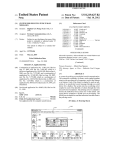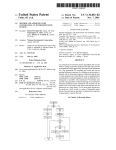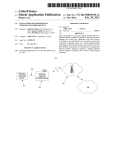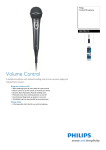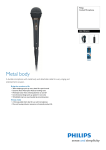Download L )(REC)
Transcript
US 20130238997A1 (19) United States (12) Patent Application Publication (10) Pub. No.: US 2013/0238997 A1 IIDA (43) Pub. Date: (54) STORAGE AND REPORDUCTION (30) Sep. 12, 2013 Foreign Application Priority Data APPARATUS (71) Applicant: MOBILEMEDIA IDEAS LLC, Chevy Aug. 7, 1997 (JP) ................................... .. 09-213656 Aug. 8, 1997 (JP) ................................... .. 09-215209 Chase, MD (US) Publication Classi?cation (72) Inventor: Kenichi IIDA, Saitama (JP) (51) (73) Assignee: MOBILEMEDIA IDEAS LLC, Chevy Chase, MD (US) Int. Cl. G06F 3/16 (52) US. Cl. CPC (21) Appl- No: 13/863,237 (22) Filed: ..... . . . . .. G06F 3/167 (2013.01) USPC ........................................................ .. 715/716 Apr. 15, 2013 (57) . . A Related U's' Apphcatlon Data (60) (2006.01) ABSTRACT ortable hand-held a aratus includes a semiconductor melfnory, a reproductionplilock, a display, a control block, a Continuation of application No. 12/651,028, ?led on housing, and an operation block con?gured to supply a signal Dec. 31, 2009, noW Pat. No. 8,423,714, Which is a continuation of application No. 11/742,641, ?led on May 1, 2007, noW Pat. No. 7,725,652, Which is a continuation of application No. 10/870,195, ?led on Jun. 17, 2004, noW Pat. No. 7,313,647, Which is a division of application No. 10/043,506, ?led on Jan. 10, 2002, noW Pat. No. 6,775,753, Which is a division to the control block depending on user manual inputs. The operation block includes a circuit at a surface of the housing con?gured to detect a ?rst user manual gesture in a ?rst of application No. 09/703,885, ?led on Nov. 1, 2000, perpendicular to the housing surface. The ?rst and second direction approximately parallel to the housing surface, a second user manual gesture in a direction opposite to the ?rst direction and also approximately parallel to the housing sur face, and a third user manual gesture in a direction that is noW Pat. No. 6,339,814, Which is a division of appli gestures are used to select a particular one of the one or more cation No. 09/128,744, ?led onAug. 4, 1998, noW Pat. pieces of sound data, and reproduction of a particular piece of No. 6,490,235. sound data occurs in response to the third gesture. 62 ,' 51 52 re» L )(REC) Patent Application Publication Sep. 12, 2013 Sheet 2 0f 15 US 2013/0238997 A1 Patent Application Publication Sep. 12, 2013 Sheet 4 0f 15 ADDRESS US 2013/0238997 A1 CONTENTS 0 Byte FOR ETERNAL BLOCK RECOGNITION 1 Byte I=OR ETERNAL BLOCK RECOGNITION 2 Byte FOR ETERNAL BLOCK RECOGNITION 3 Byte FOR ETERNAL BLOCK RECOGNITION 4, 5 Byte ETERNAL BLOCK ADDRESS 6, 1 Byte INDEX STAGE 0 AOBREss s, 9 Byte INDEX sTAGE 1 ABOREss 10, 11 Byte wORK AREA BLOCK START ABBREss (uPPER) 12 Byte DUMMY DATA I l 15 Byte DUMMY OATA 1e Byte BLANK MAP I BLANK MAP 143 Byte BLANK MAP NO DATA (0 >< FF) FIG.4 Patent Application Publication PAGE Sep. 12, 2013 Sheet 5 0f 15 US 2013/0238997 A1 CONTENTS Page 0 ADR DATA BLOCK Page 1 (PCM DATA START AND END ADDRESS, SPILP) Page 2 6 Byte >< (469x 2 block) = 5628 byte Page 3 5628 byte : 1 0.99 page Page 4 Page 5 Page 6 Page 7 Page 8 Page 9 Page 10 Page 11 Page 12 HDR DATA BLOCK Page 13 (PRIORITY, ALARM DATA) Page 14 8 byte X 99 PIECES = 792 byte Page 15 792 byte = 1.55 page FIG.5 Patent Application Publication Sep. 12, 2013 Sheet 7 0f 15 US 2013/0238997 A1 56E Patent Application Publication PAGE Sep. 12, 2013 Sheet 8 0f 15 US 2013/0238997 A1 CONTENTS Page 0 Page 1 VALID MARK (0 Byte) MODE INTERFIUPT MARK (1 Byte) Page 2 Blank Map (0 ~ 127 Byte) Page 3 Eternal block Blank Map (0 ~ 127 Byte) Page 4 Page 5 Page 6 Page 7 Page 8 Page 9 Page 10 Page 11 Page 12 Page 13 Page 14 Page 1 5 FIG.8 Patent Application Publication Sep. 12, 2013 Sheet 9 0f 15 ADDRESS US 2013/0238997 A1 CONTENTS 0 Byte 1 Byte 2 Byte ID No. SP/LP INFORMATION PCM DATA STORAGE START ADDRESS (UPPER) 3 Byte PCM DATA STORAGE START ADDRESS (LOWER) 4 Byte PCM DATA STORAGE END ADDRESS (UPPER) 5 Byte PCM DATA STORAGE END ADDRESS (LOWER) FIG.9 ADDRESS CONTENTS 0 Byte PCM DATA 1 Byte PCM DATA l PCM DATA 51o Byte PCM DATA s11 Byte PCM DATA s12 Byte YEAR DATA 513 Byte MONTH DATA 514 Byte s15 Byte DAY DATA HOUR DATA 516 Byte MINUTE DATA 517 Byte SECOND DATA 51a Byte DAY OF WEEK 519 Byte CLOCK sET FLAG 520 Byte NO DATA (0 >< FF) t 527 Byte FIG.1O Patent Application Publication Sep. 12, 2013 Sheet 10 0f 15 US 2013/0238997 A1 Rggggglga No.1 No.2 No.3 No.4 No.5 No.6 REQEIEENG No.1 No.2 No.3 No.4 No.5 No.6 L‘ NEW PIECE RECORDED FIG.11 @ REPRODUCTION f51 S2 REC BUTTON PRESSED 1 SECOND OR MORE YES I STOP REPRODUCTION If ' 83 84 START REPRODUCTION 4 S5 STOP BUTTON PRESSED ? OR MEMORY FULL ? STOP RECORDING FIG.12 No.7 Patent Application Publication :5E8szmam22m=5.5 s5:5E822m25IEEu mm:5s68zzw22m12m25E22w5w :5Emmm,5825E22m12m Sep. 12, 2013 Sheet 11 0f 15 E E E E .5aiw E$:6m8U?E5w3B$3:25mH02g.5?:Ewe:5Nm"zEamBg EmnsHazmcngs US 2013/0238997 A1 Patent Application Publication Sep. 12, 2013 Sheet 12 0f 15 US 2013/0238997 A1 CURRENT REPRODUCTION POSITION I BEFORE RECORDING No. 1 No. 2 No. 3 REC KEY LO'NG PRESSING 0FI1 SEC AFTER RECORDING N0. 1 N0. 2 FIG.14 DATA ADDED N0. 3 Patent Application Publication Sep. 12, 2013 Sheet 13 0f 15 57 US 2013/0238997 A1 64 B d PRESSING :> X C b ROTATION A / _6Q_ 63 64a FIG.15A 65 63a mU‘Q FIG.15B Patent Application Publication SHAFT ROTATION Sep. 12, 2013 Sheet 14 0f 15 US 2013/0238997 A1 OUTPUT WAVEFORM S'GNAL on (BETWEEN TERMINATS a—c) cw ON OFF (B DIRECTION) ON __.. B (BETWEEN TERMINATS b—C) OFF (1 (BETWEEN TERMINATS a-c) ON OFF [3 (BETWEEN TERMINATS b-C) OFF ccw (A DIRECTION) ON -.. EACH PAIR 15 PULSES 360‘ FIG.16 JOG cw JOG PRESSING RELEASE CUE 1 J06 ccw WHILE PRESSED PLAY JOG cw WHILE PHESSED REV JOG ccw JOG PRESSING RELEASE FIG.17 Patent Application Publication Sep. 12, 2013 Sheet 15 0f 15 US 2013/0238997 A1 PLAY J06 SHORT PRESSING FAST SEARCH (+ n) SLOW SEARCH (+1) JOG CCW FAST JOG CCW SLOW STOP JOG CW FAST JOG cw sLow FAST SEARCH (- n) SLOW SEARCH (—1) JOG LONG PRESSING 1 SCAN REPRODUCTION JOG PRESSED FIG.18 PLAY JOG SHORT PRESSING FAST SEARCH (+11) SLOW SEARCH (+1) JOG CCW FAST JOG CCW SLOW STOP JOG CW FAST JOG CW SLOW FAST SEARCH (— n) SLOW SEARCH (—1) JOG PRESSING on SINGLE ROTATION JQG LONG PRESS'NG REPEAT FIG.19 Sep. 12, 2013 US 2013/0238997 A1 STORAGE AND REPORDUCTION APPARATUS CROSS-REFERENCE TO RELATED APPLICATIONS [0001] This application is a Continuation of and claims the bene?t of priority under 35 U.S.C. §120 from US. Ser. No. 12/651,028, ?led Dec. 31, 2009, Which is a Continuation of application Ser. No. 11/742,641, ?led on May 1, 2007, now US. Pat. No. 7,725,652, Which is a continuation of applica tion Ser. No. 10/870,195, ?led on Jun. 17, 2004, now US. Pat. No. 7,313,647, Which is a division of application Ser. No. 10/043,506, ?led on Jan. 10, 2002, now US. Pat. No. 6,775, 753, Which is a division of application Ser. No. 09/703,885, ?led on Nov. 1, 2000, now US. Pat. No. 6,339,814, Which is a division ofapplication Ser. No. 09/128,744, ?led onAug. 4, 1998, now US. Pat. No. 6,490,235, Which claims the bene?t of priority under 35 U.S.C. §119 from Japanese Patent Appli cation Nos. 09-215209, ?led Aug. 8, 1997 and 09-213656, stored in memory. This requires a complicated operation pro cedures to read out a necessary ?le from memory and repro duce it. [0010] In order to read out from memory and reproduce a target sound data in the aforementioned recording/reproduc tion apparatus using a semiconductor memory, a user needs to operate a plurality of operation buttons such as a reproduction button, forWard direction search button, and reverse direction search button. More speci?cally, When a plurality of data pieces are recorded in a semiconductor memory, prior to reproduction, it is necessary to press a forWard direction search button and a reverse direction search button to select a target data piece to be reproduced so that an index number of the target data piece is displayed in a display block of the apparatus. After this, a reproduction button is pressed so as to reproduce the target sound data. Here, if a plenty of index numbers are involved, the user needs to continuously press the search button so as to display the target index number. SUMMARY OF THE INVENTION ?led Aug. 7, 1997. The entire contents of each of the above applications are incorporated herein by reference. BACKGROUND OF THE INVENTION [0011] It is therefore an object of the present invention to provide a storage and reproducing apparatus Which resolves the above-mentioned problem. [0002] 1. Field of the Invention [0003] The present invention relates to a storage and repro duction apparatus, and in particular to a storage and repro duction apparatus using a semiconductor memory. [0012] One aspect of the present invention is directed to a portable hand-held apparatus that includes a semiconductor [0004] [0005] to reproduce one or more of the pieces of sound data as sound 2. Description of the PriorArt NoWadays, there are recording/reproduction appa ratus Which can easily be used for recording/reproducing a sound just like Writing doWn contents of a lecture or discus sion on a memo paper. Such a recording/reproduction appa ratus uses a semiconductor memory as a recording medium for storing a sound signals as a predetermined number of ?les and the sound signal is reproduced to output a sound. More speci?cally, the recording/reproduction apparatus stores a sound data consisting of a plurality of ?les in a semiconductor memory con?gured to store one or more pieces of sound data and a reproduction block including a loudspeaker con?gured signals from the loudspeaker. This apparatus also includes a display panel con?gured to display selectable information corresponding to each of one or more of the pieces of sound data, a control block that includes a microcomputer and a program that is executable by the microcomputer to control the apparatus, and a housing con?gured for hand-held opera tion containing the reproduction block, the display panel and sound data, starting With an older ?le. the control block. This apparatus also includes an operation block con?gured to supply a signal to the control block depending on user manual inputs to the operation block. The operation block includes a circuit at a surface of the housing [0006] When Writing doWn contents of a discussion on a memo notebook, the latest content is Written on a laterpage of direction approximately parallel to the housing surface, a the memo notebook. Accordingly, When reading the contents afterward, it is necessary to turn pages to read the latest direction and also approximately parallel to the housing sur memory and upon reproduction, successively reproduces the con?gured to detect a ?rst user manual gesture in a ?rst second user manual gesture in a direction opposite to the ?rst contents. face and a third user manual gesture in a direction that is [0007] This inconvenience is also met in a recording/repro duction apparatus in a semiconductor apparatus Which stores a latest sound as a last ?le in a semiconductor memory, Which perpendicular to the housing surface. The circuit of the opera tion block is con?gured to detect the ?rst user manual gesture and the second user manual gesture in selecting a particular requires search of the ?le containing the latest sound prior to reproducing the latest sound. panel displays the selectable information corresponding to [0008] Those ?les stored in memory can be erased When they have become unnecessary. HoWever, When there is a necessity to reproduce a ?le or When neW ?les are succes one of the one or more pieces of sound data When the display the particular one of the one or more of the pieces of sound data. The reproduction block is con?gured to reproduce the particular one of the one or more pieces of sound data in sively stored Without any time to erase them, more important response to the circuit of the operation block detecting the ?les tend to be recorded at the last Write-in address or read-out third user manual gesture. address of memory. Accordingly, as more and more ?les are recorded, there Will be contained more ?les Which are scarcely to be assessed. Those ?les Which are not so important are ?rst to be read out from memory to be reproduced and the latest ?le Which has been just recorded tends to be the last to be reproduced. [0009] That is, When a user Wants to reproduce a sound data of the latest important ?le, he/ she needs to carry out an opera tion for search the target latest ?le from a plurality of ?les BRIEF DESCRIPTION OF DRAWINGS [0013] FIG. 1 is a block diagram shoWing a speci?c con ?guration of an IC recorder according to the present inven tion. FIG. 2 is an external front vieW of the IC recorder. [0015] FIG. 3 shoWs a con?guration of a semiconductor memory of the IC recorder. [0014] Sep. 12,2013 US 2013/0238997 A1 [0016] FIG. 4 shows a con?guration of an eternal block of the semiconductor memory. [0017] FIG. 5 shoWs a con?guration of an index stage block constituted by a ?le data of the semiconductor memory. [0018] FIG. 6 shoWs a con?guration of anADR data block of the index stage block. [0019] FIG. 7 shoWs a con?guration ofan HDR data block of the index stage block. [0020] FIG. 8 shoWs a con?guration of an index stage block constituted by a ?le data of the semiconductor memory. [0021] FIG. 9 shoWs a con?guration of a Work area block of the semiconductor memory. [0022] FIG. 10 shoWs a con?guration of a PCM data block of the semiconductor memory. [0023] FIG. 11 explains a recording position of a neW sound data stored. [0024] FIG. 12 is a ?owchart explaining a CPU operation When additionally recording a neW sound data as of ID num ber 02. [0025] FIG. 13 shoWs a con?guration of anADR data of the index stage block When a neW sound data is additionally recorded as of ID number 02. [0026] FIG. 14 explains a storage position of a neW sound data additionally recorded as of ID number 02. [0027] FIG. 15A and FIG. 15B explain a con?guration ofa jog dial: FIG. 15A is an external front vieW of the jog dial and [0028] FIG. 15B is an external rear vieW ofthejog dial. [0029] FIG. 16 shoWs rotation directions of a rotation operation member in connection With signals outputted as a result of a jog dial rotation operation together With corre sponding output Waveforms. [0030] FIG. 17 explains an operation of a rotary operation member associated With a cue/revieW reproduction and a reproduction state transition corresponding to the operation of the rotary operation member. [0031] FIG. 18 a processing carried out When the rotary operation member is rotated or pressed in a stop state. [0032] FIG. 19 shoWs a processing carried out When the rotary operation members rotated or pressed in a sound data reproduction state. DETAILED DESCRIPTION OF PREFERRED EMBODIMENTS [0033] Hereinafter, description Will be directed to a storage and reproducing apparatus according to embodiments of the present invention With reference to the attached draWings. In the embodiments described beloW, explanation Will be given on a recording/reproduction apparatus (hereinafter, referred to simply as an IC recorder) using a semiconductor memory for recording or reproducing a sound signal. [0034] Referring to FIG. 1, this IC recorder 1 includes: a recording block 10 for converting an analog sound signal from a microphone 11, into a digital sound data and storing the digital sound data in a semiconductor memory 9; a repro duction block 20 for reading out the sound data stored in the semiconductor memory 9 and converting the read out sound data into an analog sound signal for reproduction output from a speaker 24; a control block 30 for controlling apparatus components including the recording block 10; a display block 40 for displaying an operation state and an operation proce dure; and an operation block 50 through Which a user enters microphone 11; an automatic gain controller (hereinafter, referred to as AGC) circuit for adjusting a level of the sound signal ampli?ed by the ampli?er 12; an encoder 14 for con verting the sound signal from the AGC 13, into a sound data; and a buffer memory 15 for temporarily accumulating the sound data from the encoder 14. [0036] In the recording block 10, the microphone 11 con verts a speaker’s voice into an analog signal for supply to the ampli?er 12. The ampli?er 12 ampli?es the analog sound signal for supply to the AGC 13. The AGC 13 ampli?es the signal from the ampli?er 12 so that the analog sound signal is at a proper level for supply to the encoder 14. [0037] Because the analog sound signal supplied via the AGC 13 has a strong temporal correlation, the encoder 14 employs, for example, the adaptive differential pulse code modulation (hereinafter, referred to ADPCM) to encode an analog sound signal With a small data amount, to create a digital sound data and supplies the created sound data to the buffer memory 15. The encoder 14 can adjust a sound data coding amount according to tWo modes. For example, in an SP mode, a sound signal is sampled With an 8 kHZ sampling frequency if in an SP mode and With a 4 kHZ sampling frequency if in an LP mode so as to adjust a sound signal coding amount in the temporal axis direction. [0038] The buffer memory 15 temporarily accumulates a sound data supplied from the encoder and supplies the accu mulated data to the semiconductor memory 9. [0039] The semiconductor memory 19 is constituted, for example, by an electrical erasable/programmable read only memory (hereinafter, referred to as an EEPROM), i.e., an non-volatile semiconductor memory Which maintains a stor age content of a storage element even if a memory drive poWer is turned off This semiconductor memory 9 stores a sound data supplied from the buffer memory 15 and a man agement information (hereinafter, referred to as a TOC infor mation) for carrying out a management, for example, Which sound data is stored in Which area. More speci?cally, the semiconductor memory 9 is, for example, a NAND type ?ash memory having a storage capacity of 4M><8 bits or 8x16 M bits, enabling to store a sound data corresponding to a sound signal of a predetermined frequency band for 30 minutes. For example, When the memory 9 has a storage capacity of 8x16 M bits, it is possible to store a sound data corresponding to a sound signal of 200 to 3400 HZ for 16 minutes in the afore mentioned SP mode and to store a sound data corresponding to a sound signal of 200 to 1700 HZ for 24 minutes in the aforementioned LP mode. [0040] On the other hand, the reproduction block 20, as shoWn in FIG. 1, has a decoder 21 for converting a sound signal read from the semiconductor memory 9, into a sound signal, a ?lter 22, and an ampli?er 23 for amplifying the sound data from the ?lter 22 for supply to a loud speaker 24. [0041] The decoder 21 corresponds to the encoder 14 of the recording block 10, and decodes a sound data Which has been encoded by the ADPCM method, so as to create a so-called PAM signal. The ?lter 22 removes a high frequency compo nent exceeding a voice frequency band from the PAM signal and outputs an analog sound signal. The ampli?er 23 ampli ?es the analog sound signal supplied from the ?lter 22. The loud speaker 24 is driven according to a signal from the ampli?er 23. Thus, a sound recorded in the memory 9 is various operations. outputted from the loud speaker 24. [0035] The recording block 10 has: an ampli?er 12 for amplifying a an analog sound signal outputted from the [0042] The control block 30 includes: a ROM 31 containing a program for controlling the IC recorder; a microcomputer Sep. 12,2013 US 2013/0238997 A1 (hereinafter, referred to as a CPU) 32 for executing the pro gram stored in the ROM 31 to control respective blocks; a the jog dial 60. The buttons and sWitches of the operation random access memory (hereinafter, referred to as a RAM) 34 surfaces of the casing 2 and can be operated With left hand ?ngers While the entire IC recorder 1 is held on the left hand for temporarily storing the time of a timer 33 for creating a clock information, a program execution result, and the like; and a counter 35 for counting pulses supplied from a jog dial Which Will be detailed later. The control block 30, according to an operation setting of the operation block 50, carries out operation control of respective components of the apparatus 1. [0043] The display block 40 displays an operation state of the IC recorder 1 and a sound data storage state according to a control signal from the control block 30 and includes a liquid crystal display panel 41 and a back light 42 for illumi nating this liquid crystal display panel 41. [0044] The operation block 50 supplies various input sig block 50 are arranged on the main surface 211 and the side palm so that a the user can continue a Work such as Writing With his/her right hand. [0049] The operation buttons involved here are, as shoWn in FIG. 2, FILE button 51, MENU button 52, PRIORITY button 53, STOP button 54 for stopping a recording or the like, REC button 55 for starting a recording, and ERASE button for erasing a sound data stored in the semiconductor memory 9. These operation buttons are arranged on the main surface 211 for the external casing 2. A HOLD sWitch 57 of slide type is provided at a loWer half of a left side surface 2b of the external nals to the control block 30 When carrying out a sound record casing 2. The operation bloc 50 also includes, although not depicted, a button for turning on the back light 42 of the liquid crystal display panel 41, a volume sWitch for adjusting loud ing/reproduction. The operation block 50 has various opera tion buttons, operation sWitches, and a jog dial to be operated Which are arranged on a side surface of the external casing 2. ness of a reproduced sound, an earphone jack, and the like by a user as Will be detailed later. In the IC recorder 1, various [0050] output signals from these operation buttons/sWitches ad the a plurality of ?les set in the IC recorder 1. The term ?le corresponds to a directory or folder used in a personal com puter. In this embodiment, ?ve types of ?les are set before hand. That is, in this IC recorder 1, each of the ?les can store up to 99 sound data pieces. The ?le types can be identi?ed by jog dial are supplied to the control block 30. [0045] The CPU 32 of the control block 30, according to a signal supplied from the operation block 50, reads out from the ROM and executes a corresponding program and controls Here, the FILE button 51 is used to sWitch betWeen the respective blocks according to the program Which has displaying different icons on the liquid crystal display panel been read out. For example, if a recording start button Which Will be detailed later is pressed, the CPU 32 reads out from the ROM and executes a program corresponding to a recording 41. operation and controls to operate the ampli?er 12, the AGC 13, the encoder 14, the display block 40, and the like accord setting of the IC recorder 1 such as modi?cation of a data and time, modi?cation of a frequency band of a sound data to be ing to the program Which has been read out, so that a sound recorded, modi?cation of output of a beep sound and alarm data temporarily accumulated in the buffer memory 15 is Written in an empty area of the semiconductor memory, for example. For reproduction of a sound data, the CPU 32 reads out from the ROM and executes a program corresponding to a reproduction operation and according to the program Which has been read out, control to operate the decoder 21, the ?lter 22, the ampli?er 23, the display block 40, and the like, so that a sound data stored in a predetermined area of the semicon ductor memory 9 is read out and converted into an analog sound signal so as to be outputted from the loud speaker 24. [0046] Thus, the control block 30 controls a sound data Writing and reading out into/from the semiconductor memory 9 and Write up to 99 sound data pieces, for example, into the semiconductor memory 9 by adding an index number to identify each of the sound data pieces. According to the index number added to each of the sound data pieces, the control block 30 controls to read out a target sound data piece from the semiconductor memory 9. [0047] Next, explanation Will be given on the operation block 50 of the IC recorder 1 With reference to FIGS. 1 and 2. FIG. 2 is an external vieW brie?y shoWing an external con ?guration of the IC recorder 1. The IC recorder shoWn in FIG. 2 is a portable type has an external casing 2 of a siZe to be grasped by one hand. In this external casing 2 is arranged a printed circuit board (not depicted) Where the aforementioned electric circuits such as recording block 10 and the reproduc tion block 20 are mounted. On a main surface 211 of this [0051] The MENU button 52 is used to operate during a stop state of recording/reproduction so as to modify the initial sound given upon pressing of the operation buttons, modi? cation of sensitivity of the microphone, and the like. [0052] The PRIORITY button 53 is pressed during a repro duction operation or a stop state of the apparatus 1 so as to determine the reproduction priority for a sound stored in the memory 9. When this PRIORITY button 53 is pressed, an index number of a target sound data such as a data Which is being reproduced is modi?ed to a smaller number. In that ?le, a sound data having an index number modi?ed by the PRI ORITY button 53 is reproduced With a higher priority. [0053] The HOLD sWitch 57 is used to maintain an opera tion state or a stop state of the IC recorder 1. When this HOLD sWitch is in ON state, the IC recorder 1 is in a state not to accept operation of the operation buttons 51 to 56 and the jog dial 60. The con?guration of the jog dial 60 and a reproduc tion operation using the jog dial 60 Will be detailed later. [0054] Here, as shoWn in FIG. 3, When a sound data and other data are stored in the semiconductor memory 9, the data is divided into 512 blocks Which are erase units. These blocks are grouped into six types as folloWs: an eternal block (1 block), index stage 0 blocks (6 blocks), index stage 1 blocks (6 blocks), a back-up block (1 block), Work area blocks (15 blocks), and PCM data blocks (469 blocks). [0055] The aforementioned TOC information consists of the eternal block, index stage 0 block, index stage 1 block back-up block, and Work area block. A sound data is Written This IC recorder 1 has on the main surface 211 and into PCM data blocks. [0056] As shoWn in FIG. 3, each ofthe blocks consists of l 6 pages (each page consisting of 528 bytes): page 0, page 1, . . side surfaces of the external casing 2, various operation but tons/sWitches 51 to 57 constituting the operation block 50 and . , page 14, page 15. Each one page consists ofa 5 l 2-byte data area and a l6-byte redundant area. Ten blocks at maximum external casing 2 are arranged the aforementioned liquid crystal display panel 41 an the loud speaker 24. [0048] Sep. 12,2013 US 2013/0238997 A1 exist as blocks disabled for data recording and/or reproduc tion (hereinafter, referred to as invalid blocks). [0057] The eternal block is provided other than at the ?rst and the last blocks of the memory 9, i.e., other than at the memory Write-in or read-out start and end addresses. The eternal block contains a management information Which is ?rst to be read out from the memory 9. According to the data of the eternal block, the index stage 0 blocks and the index stage 1 blocks are read out. Thus, the eternal block is indis pensable for reading out a data stored in the other blocks and accordingly located at a position other than the head and end addresses of the memory 9 Which have the highest possibility of destruction upon an abnormal operation such as static electricity and an abnormal voltage. For example, if a block containing a sound data is destroyed, the data in the broken block can be erased so that a neW sound data can be recorded number 03 consists of four ?les, for example. In this case, for each of the ?les, a recording mode and a start address and an end address are recorded. [0064] FIG. 7 shoWs a con?guration of the HDR block. The folloWing are recorded for each ?le; PRI indicating a ?le priority set by operation of the PRIORITY button 53 of the operation block 50; ALM indicating ON/OFF of the alarm setting by the operation of the MENU button 52; AMO, ADA, AHO, AMI, and AOW indicating the month, day, hour, minute, day of the Week When the alarm is to be actuated. Here, as has been described above, the priority indicates a reproduction priority of a sound data When the sound data is reproduced. The HDR data block is updated When the priority or alarm setting is modi?ed by operation of the PRIORITY button 53 and the MENU button 52 even if no sound data is updated. Without any problem. HoWever, if the eternal block is [0065] destroyed, no data can be read out from the other blocks. To avoid such a situation, the eternal block is located, as has been a stage data, as shoWn in FIG. 8, has a valid mark on page 0, described above, at other than the blocks of the memory 9 start and end addresses. [0058] In the eternal block, only page 0 contains a data, and On the other hand, the index stage block containing a mode interruption mode on page 1, a blank map on page an eternal block blank map on page 3. [0066] The back-up block is a back-up for the aforemen tioned eternal block and is a copy of the eternal block. Con pages 1 to 15 contain no data. More speci?cally, as shoWn in sequently, When the eternal block is reWritten, the back-up FIG. 4, page 0 of the eternal block includes a 4-byte eternal block is also reWritten. There may be more than one back-up blocks. block recognition data, 2-byte eternal block address, 3-byte index stage 0 address, 2-byte index stage 1 address, 2-byte Work area block start address, 4-byte dummy data, and 128 byte blank map. The blank map indicates locations of the aforementioned invalid blocks. [0059] The index stage 0 blocks and the index stage 1 blocks have an identical data con?guration and these blocks are alternately rewritten for each sound data reWriting. That is, When a sound data is Written in the memory 9, for example, a data in an index stage 0 block is reWritten, and When another sound data is Written in the memory 9, a data in an index stage block is reWritten. Hereinafter, these blocks Will be referred to as index stage blocks in general. [0067] The Work area block is an area for temporarily recording an index data during a sound data recording. As shoWn in FIG. 9, the Work area block has an almost identical data con?guration as the index stage block. The Work area block contains an index number, SP/LP information indicat ing the recording mode, a sound data upper start address, a sound data loWer start address, a sound data upper end address, a sound data loWer end address, each of Which con sists of 1 byte. In this Work area block, While reading data from the Work area block, the index stage block is reWritten and the data such as the start address is directly Written as it is. [0068] The PCM data block is an area Where a sound data is [0060] As has been described, there are 6 index stage blocks for stage 0 and stage 1, respectively: ?ve blocs con taining a ?le data and one block containing a stage data. mainly recorded. AS shoWn in FIG. 10, in the PCM data [0061] FIG. 5 shoWs a con?guration of an index stage block having a ?le data Which consists of anADR data block of page by the timer 33 are also recorded. More speci?cally, a 512 0 to page 11 and an HDR block of page 12 to page 15. [0062] FIG. 6 shoWs a con?guration of the ADR data block, Which has, for example, ID numbers 01 to 06; SP Which indicates the recording mode SP or LP corresponding to a coding amount by the aforementioned encoder 14 for each of the ?les containing a sound data; STH indicating an upper start address and STM indicating a loWer start address of the ?le; ENH indicating an upper end address and ENM indicat ing a loWer end address of the ?le. [0063] For example, When 6 sound data pieces are recorded, as shoWn in FIG. 7, in the ADR data block, index numbers 01 to 06 are recorded corresponding to the six sound data pieces. This index number is a data indicating a repro duction sequence of the six sound data pieces recorded. For each of the index numbers, recording mode (SP) together With a start address (STH, STM) and an end address (ENH, ENM) of the area containing the sound data are recorded. Because the sound of the index number 01 and the sound data of the index number 03 have a large capacity, as shoWn in FIG. 6, the index number 01 consists of tWo ?les and the index block, each one page contains besides a sound data, the year, month, day, hour, minute, second, and day of the Week created byte sound data, l-byte data of year, l-byte data of month, l-byte data of day, l-byte data of hour, l-byte data of minute, l-byte data of second, and l-byte clock set ?ag are recorded on one page. [0069] In the IC recorder 1 having the aforementioned con ?guration, if the REC button 56 is pressed When no recording or reproduction is carried out, the CPU 32 controls to Write a sound data in the semiconductor memory 9. It is assumed that in the semiconductor memory 9, already six sound data pieces have been recorded as shoWn in FIG. 6. [0070] More speci?cally, When the REC button 56 is pressed, the CPU 32 reads out from the ROM 31 and executes a program corresponding to the recording operation so that the ampli?er 12, the AGC 13, and the encoder 14 are actuated and a sound data delayed With a predetermined time via the buffer memory 15 is stored in the PCM data block of the semiconductor memory 9. [0071] For each of the data blocks, the CPU 32 stores a 5l2-byte sound data ad creates a data of the recording year, month, day, hour, and minute to be recorded together With the sound data in the PCM data block. The CPU 32 controls to



























